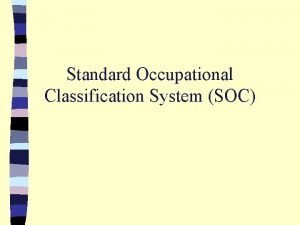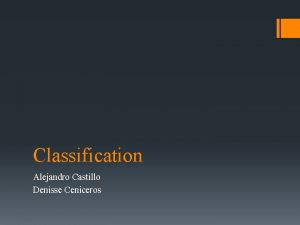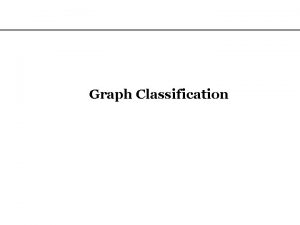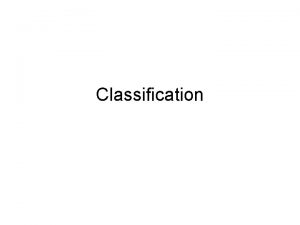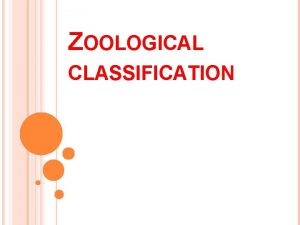International Standard Classification of Education The International Standard












- Slides: 12

International Standard Classification of Education The International Standard Classification of Education (ISCED) is a statistical framework for organizing information on education maintained by the United Nations Educational, Scientific and Cultural Organization (UNESCO). It is a member of the international family of economic and social classifications of the United Nations.

International Standard Classification of Education • The ISCED was designed in the early 1970 s to serve ‘as an instrument suitable for assembling, compiling and presenting statistics of education both within individual countries and internationally’. [2] The first version, known as ISCED 1976, was approved by the International Conference on Education (Geneva, 1975), and was subsequently endorsed by UNESCO’s 19 th General Conference in 1976.

International Standard Classification of Education The second version, known as ISCED 1997, was approved by the UNESCO General Conference at its 29 th session in November 1997 as part of efforts to increase the international comparability of education statistics. It covered primarily two crossclassification variables: levels (7) and fields of education (25). The UNESCO Institute for Statistics led the development of a third version, which was adopted by UNESCO’s 36 th General Conference in November 2011 and which will replace ISCED 1997 in international data collections in the coming years. [3] ISCED 2011 has 9 rather than 7 levels, created by dividing the tertiary pre-doctorate level into three levels. It also extended the lowest level (ISCED 0) to cover a new sub-category of early childhood educational development programmes, which target children below the age of 3 years.

International Standard Classification of Education During the review and revision, which led to the adoption of ISCED 2011, UNESCO Member States agreed that the fields of education should be examined in a separate process. This review is now underway with the view to establishing an independent but related classification called the ISCED Fields of Education and Training. Related materials from the European Centre for the Development of Vocational Training and also Eurostat provide further information and statistical guidance for the classification of subfields of education as a companion to ISCED.

ISCED 0: pre-primary education • Programs at level 0, (pre-primary) defined as the initial stage of organised instruction are designed primarily to introduce young children to a school-type environment, i. e. to provide a bridge between the home and a school based atmosphere. Upon completion of these programs, children continue their education at level 1 (primary education).

ISCED 1: primary education or first stage of basic education • Programmes at level 1 are normally designed on a unit or project basis to give students a sound basic education in reading, writing and mathematics along with an elementary understanding of other subjects such as history, geography, natural science, social science, art and music. In some cases religious instruction is featured. The core at this level consists of education provided for children, the customary or legal age of entrance being not younger than five years or older than seven years. This level covers, in principle, six years of full-time schooling.

ISCED 2: lower secondary education or second stage of basic education • The contents of education at this stage are typically designed to complete the provision of basic education which began at ISCED level 1. In many, if not most countries, the educational aim is to lay the foundation for lifelong learning and human development. The programmes at this level are usually on a more subject oriented pattern using more specialised teachers and more often several teachers conducting classes in their field of specialisation. The full implementation of basic skills occurs at this level. The end of this level often coincides with the end of compulsory schooling where it exists.

ISCED 3: upper secondary education • This level of education typically begins at the end of full-time compulsory education for those countries that have a system of compulsory education. More specialisation may be observed at this level than at ISCED level 2 and often teachers need to be more qualified or specialised than for ISCED level 2. The entrance age to this level is typically 15 to 16 years. • ISCED 3 A: programmes designed to provide direct access to ISCED 5 A; • ISCED 3 B: programmes designed to provide direct access to ISCED 5 B; • ISCED 3 C: programmes not designed to lead to ISCED 5 A or 5 B.

ISCED 4: post-secondary non tertiary education • ISCED 4 captures programmes that straddle the boundary between upper secondary and postsecondary education from an international point of view, even though they might clearly be considered as upper secondary or post-secondary programmes in a national context. These programmes can, considering their content, not be regarded as tertiary programmes. They are often not significantly more advanced than programmes at ISCED 3 but they serve to broaden the knowledge of participants who have already completed a programme at level 3. Typical examples are programmes designed to prepare students for studies at level 5 who, although having completed ISCED level 3, did not follow a curriculum which would allow entry to level 5, i. e. predegree foundation courses or short vocational programmes. Second cycle programmes can be included as well. • ISCED 4 A: see text for ISCED 3 • ISCED 4 B: see text for ISCED 3 • ISCED 4 C: see text for ISCED 3

ISCED 5: first stage of tertiary education (not leading directly to an advanced research qualification) This level consists of tertiary programmes having an educational content more advanced than those offered at levels 3 and 4. Entry to these programmes normally requires the successful completion of ISCED level 3 A or 3 B or a similar qualification at ISCED level 4 A. They do not lead to the award of an advanced research qualification (ISCED 6). These programmes must have a cumulative duration of at least two years.

ISCED 5: first stage of tertiary education (not leading directly to an advanced research qualification) • ISCED 5 A: programmes that are largely theoretically based and are intended to provide sufficient qualifications for gaining entry into advanced research programmes and professions with high skills requirements. • ISCED 5 B: programmes that are practically oriented/ occupationally specific and are mainly designed for participants to acquire the practical skills and know-how needed for employment in a particular occupation or trade or class of occupations or trades, the successful completion of which usually provides the participants with a labour-market relevant qualification

ISCED 6: second stage of tertiary education (leading to an advanced research qualification) • This level is reserved for tertiary programmes which lead to the award of an advanced research qualification. The programmes are, therefore, devoted to advanced study and original research and not based on course-work only. They typically require the submission of a thesis or dissertation of publishable quality which is the product of original research and represents a significant contribution to knowledge. They prepare graduates for faculty posts in institutions offering ISCED 5 A programmes, as well as research posts in government, industry, etc.
 Classification of education
Classification of education Hát kết hợp bộ gõ cơ thể
Hát kết hợp bộ gõ cơ thể Ng-html
Ng-html Bổ thể
Bổ thể Tỉ lệ cơ thể trẻ em
Tỉ lệ cơ thể trẻ em Voi kéo gỗ như thế nào
Voi kéo gỗ như thế nào Tư thế worm breton là gì
Tư thế worm breton là gì Chúa sống lại
Chúa sống lại Các môn thể thao bắt đầu bằng tiếng chạy
Các môn thể thao bắt đầu bằng tiếng chạy Thế nào là hệ số cao nhất
Thế nào là hệ số cao nhất Các châu lục và đại dương trên thế giới
Các châu lục và đại dương trên thế giới Công thức tính độ biến thiên đông lượng
Công thức tính độ biến thiên đông lượng Trời xanh đây là của chúng ta thể thơ
Trời xanh đây là của chúng ta thể thơ
















